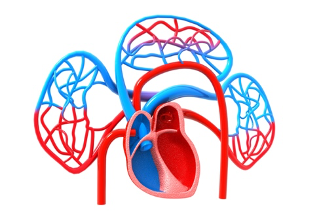The term "vascular" refers to the body's blood vessels, including arteries, veins, and capillaries. They are all connected to a muscular pump called the heart and together this system keeps a continuous and controlled movement of blood that delivers nutrients and oxygen to every cell in the body. This is done through thousands of miles of capillaries between the arteries and the veins.
As a combined practice, the Vein Institute of NJ and The Cardiovascular Care Group solely focus on the issues with the veins and arteries of your body. And as board-certified vascular surgeons, we are able to provide some of the foremost diagnostics and treatments for artery and vein issues.
However, we are often asked: What’s the difference between veins and arteries? As patient education is one of the cornerstones of our practice, allow us to give you an overview of this amazing system.
Arteries and Veins — What are the differences?
Arteries carry oxygen-rich blood from your heart to your tissues and organs. Veins carry the blood and waste products back to your heart. These are two of the body’s main types of blood vessels that distribute blood to the body. They’re part of two closed systems of tubes that begin and end at the heart. These systems of tubes are either:
-
Pulmonary. The pulmonary vessels are arteries that transport oxygen-poor blood from the heart’s right ventricle to the lungs. Pulmonary veins transport oxygen-rich blood back to the heart’s left atrium.
- Systemic. The systemic vessels are arteries that carry oxygen-rich blood from the heart’s left ventricle to the tissues in all parts of the body. They then return oxygen-poor blood through the veins back to the heart’s right atrium.

Different Types of Arteries
There are 3 types of arteries:
- Elastic arteries: These are the large vessels coming out of the heart. For example, they include the pulmonary artery and the aorta. The aorta is the main artery carrying blood away from the heart. The heart forcefully pumps blood out to keep it moving around the body. Elastic arteries must be flexible to handle surges of blood. They expand as the heart pushes blood out. Elastin is a protein found in many tissues that allow flexibility, including elastic arteries.
- Muscular arteries: Elastic arteries feed blood into muscular arteries, such as the femoral or coronary arteries. Smooth muscle fibers make up the walls of muscular arteries. The muscles allow these arteries to expand and contract. These changes in size control how much blood moves through the arteries.
- Arterioles: These are the smallest type of artery. They distribute blood from larger arteries through networks of capillaries. The outer layer of arterioles also contains smooth muscle that allows for expansions and contractions.
One of the common issues we encounter with arteries is carotid artery disease. Some people develop clogged arteries as a result from a buildup of plaque on the inner walls of the arteries. Arterial plaque can reduce blood flow or, in some instances, block it altogether.
Clogged arteries greatly increase the likelihood of heart attack, stroke, and even death. It is important to be aware, no matter how old you are, of the causes of artery plaque and treatment strategies to prevent serious consequences.
Different Types of Veins
Veins are thinner and have less muscle than arteries, allowing them to hold more blood. Veins typically contain around 70% of blood in the body at any one time. There are essentially 4 types of veins:
- Deep veins: These veins usually have a corresponding artery nearby and are in muscle tissue. These veins may have a one-way valve to prevent blood from flowing backward.
- Superficial veins: These veins do not have an artery with the same name nearby and are close to the surface of the skin. They may also have a one-way valve.
- Connecting veins: These small veins allow blood to flow from the superficial veins to the deep veins.
- Pulmonary veins: These veins transport blood that’s been filled with oxygen by the lungs to the heart. Each lung has two sets of pulmonary veins, a right and left one.
As vein specialists, the common issues we treat involve varicose veins. These are bulging, bluish cords running just beneath the surface of your skin. They almost always affect legs and feet. Visible swollen and twisted veins — sometimes surrounded by patches of flooded capillaries known as spider veins — are considered superficial.
To learn more about your veins and arteries and the associated diseases and treatments, schedule a consultation with one of our board-certified vascular surgeons today!









.jpg?width=944&name=Castle-Connolly-Top-Doctors-Emblem-Large%20(4).jpg)